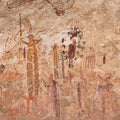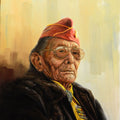Art Saves Lives, and a Cookie Factory, in Denver
By Chadd Scott on
Art saves lives. Sometimes more than once.
Art has offered Amanda Precourt salvation throughout her life, first it’s creation, now its collection.
“Around seven or eight, I started drawing all the time to try to manage my chaos, the chaos that I felt around me in the world,” Precourt said. “My parents got divorced and I was very young and so I started drawing and painting as a way to moderate my own mood.”
Drawing. Painting. She worked in ceramics as a kid. She took art classes in college at Stanford and became an architectural designer.
Born and raised in Denver, Precourt lived a life of wealth and privilege. Her father was a fossil energy tycoon. She splits her time between Denver and the jet set in Vail.
A fantasy life from the outside looking in.
On the inside, however, she struggled with anxiety and depression. In her late 30s, an endocrine problem exacerbated those conditions, and added insomnia, isolation, panic attacks, and severe exhaustion.
She says bluntly, “I didn’t want to live anymore.”
Riding in the passenger side of a car traveling full speed on Interstate 70 between Vail and Denver, Precourt opened the door and tried throwing herself out.
“I had a really, really, really near – I mean lucky to be alive – kind of a near death experience related to mental health, and I ended up in treatment,” Precourt said. “I was in treatment, and I was so anxious, and I couldn't figure out what do my thoughts. There were coloring books on the table and so I started coloring, and I feel myself immediately calm down.”
Art saved her life for a second time.
It would do so again, the most recent time, art collecting.
“I got out of treatment and I started realizing I love art. I love being around art, the color and the making of art,” Precourt said. “In treatment, my making of art calmed my nervous system, and then when I got out, I started collecting art. It led to me having a purpose and a sense of wellness because I was surrounding myself with all these beautiful artistic expressions.”
“Art is a way to experience what is the essence of being human through someone's eyes that you may not know or understand, but when you see the art, you can feel the intention of the artist to express how they feel about the world,” she added.

Cookie Factory Founder and Executive Director Amanda J. Precourt. Photo credit, Kristen Thoen.
Finding the Cookie Factory
Professionally, Precourt is a real estate developer. Mostly residential properties in Vail, but adaptive reuse in Denver as well. She cruises Denver neighborhoods for hidden gems, not totally sure of what she’s looking for or even what she’d do with one if she found it.
“I stumbled upon this old fortune cookie factory,” Precourt said. “The roof had collapsed. There were a couple inches of water in the factory. All the vats were still in there and there were fortunes all over the floor.”
A complete mess.
A thick layer of black mold coated the ceiling. What of it remained.
The family who owned the circa 1941 factory decided to sell the building rather than put in the money to repair it. Precourt purchased the property in 2017.
In addition to the massive repairs required, for Precourt to convert the building into something else – she wasn’t interested in running a cookie factory, or any kind of factory – she would need to have it rezoned. In this case, doing so would be trickier than usual because the building resides in a neighborhood with a neighborhood association that has say-so over zoning decisions.
The cookie factory had fallen out of contract multiple times before for these reasons.
Precourt explained to the neighbors her intentions of creating, “an art space, art gallery – I'm not sure – something for contemporary art, and then I want to build an apartment on top of that all to live in.”
It was hardly a firm plan, more of an idea. An idea of an idea?
“Pure intuition. This building is cool. It needs to be saved. I feel like it needs to be something around contemporary art. I'm not sure what,” Precourt remembers thinking. “I had to close (on the sale) not knowing if I was going to get any of (the rezoning). It was a leap of faith.”
The zoning decision came through in her favor. Eight years later now, having undergone extensive and complicated engineering repairs, renovations, and modifications, Precourt’s old cookie factory is ready for its next life, with her living in an apartment on top.
“We're in this little neighborhood called Baker. We're the only commercial building,” she explained. “It's a lot of artists and musicians in this neighborhood. We want to foster a neighborhood kind of hang out.”

View of Cookie Factory exterior. Photo credit, Kimberly Gavin.
Opening the Cookie Factory
Cookie Factory opens on May 24, 2025, as a new contemporary arts space. Committed to fostering creative collaboration and dialogue, the factory has been transformed into a 5,000-square-foot public arts platform with exhibition and studio spaces, a small theater for digital and video art, and an outdoor sculpture garden to present large-scale works.
A solo exhibition of new, large-scale, site-specific works by Sam Falls created while staying at Precourt’s ranch in Colorado’s Yampa Valley last fall kicks off the programming. Cookie Factory is committed to collaborating with emerging and internationally renowned artists to create new, exclusive works inspired by the context and landscapes of Denver and Colorado.
“The reason why Cookie Factory is unique is because the art is made specifically for the space and these are artists that might be missed by larger institutions,” Precourt explained. “They probably wouldn't be on the radar of these museums to come in and do a whole show; the Denver Art Museum might buy one piece, but we're trying to bring artists that aren't represented in Denver anywhere.”

Sam Falls developing artworks in Colorado’s Yampa Valley. Photo credit, Third Dune Productions.
Precourt has been a member of the Board of Trustees at the Denver Art Museum for many years and works regularly with the Museum of Contemporary Art Denver. For her own space, she was looking for something between a museum on one end and a collective/residency for local artists on the other.
“We hope that Cookie Factory will be a place where people come to see the art. People come to experience the artists,” Precourt said. “We're going to have events and programming, but we want to create a community around people wanting to connect with one another through the shared experience of art.”
Considering her background, the art must serve a greater purpose.
“Wellness comes through connection. We're not meant to be lone wolfs, we're pack animals,” Precourt said. “Creating community around art, not just going to a museum and looking at it and then leaving, but coming to a space, being with the art, and then having an event and hanging out, having a painting class. We want this to be a place where people come back and bring their friends.”
To begin with, Cookie Factory will only be open on Wednesdays with special events taking place at least once a month on weekends. Precourt has designs on more. She’s already acquired additional properties nearby with plans to develop a coffee shop and artist studios.
Oh, and the first piece of art Precourt collected after treatment, one of Jeffrey Gibson’s (b. 1972; Mississippi Band of Choctaw Indians and Cherokee descent) beaded punching bags!



